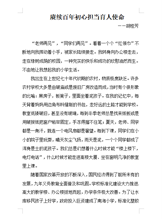如何提高雅思阅读做题效率
选择正确雅思阅读答题顺序,助你提高做题效率一文主要有2方面的内容。首先我们为大家阐述掌握正确做题顺序的重要性和思路,接着告诉大家雅思阅读10多类题型的做题顺序。下面小编就和大家分享,来欣赏一下吧。
选择正确雅思阅读答题顺序,助你提高做题效率
选择正确雅思阅读答题顺序,助你提高做题效率为大家带来在进行雅思阅读的解题时,怎样依据正确的答题顺序进行做题以便提高阅读的做题速度。雅思阅读有3篇文章40几道题,而且题型多变,常见的雅思阅读题型有10多种。在短短的答题时间内,如果能够掌握正确的答题顺序,你的阅读做题效率提高将会大大提高。
选择正确阅读法,提高雅思阅读速度
第一:选择科学的阅读方法
其实雅思的阅读量是非常大的,一般的对于中国考生来说根本无法把文章全部读完,于是合理的“跳读”和“略读”就成了考试时无法取代的阅读方法。因为这样能够节省很多做题时间,如果你想像练习时的精读一样,那么你是根本不可能完成整个雅思阅读考试。那么在你们选择雅思阅读答题顺序中跳读和略读就要注意一些阅读的细节:
1.读完题目再做题,如果题目的话过度可以先读前几题,然后再带着问题进行第二次阅读,这样将会变得更加的有目的性,哪怕遇到重点信息也不至于漏掉,以至于能够反复回文定位。
2.仔细分析文章首尾段或者各个段落的首句的意思,理解大意。这样你们将会对文章内容有个大致的了解,打个比方这篇文章讲的是生物化学,或者是环境计划护还是宇宙探索。一定要搞清楚文章的主题和作者想表达的内容。
3.标记定位词的重要性。所谓定位词,顾名思义就是一个可以根据题干回原文定位,并且能够为你找到出处的词,这样能够帮助你做到快速锁定答案解题。其实也就是我们所说的关键词。这也是为你能够节省阅读时间的一种科学的雅思阅读答题顺序。
第二:仔细阅读题干,开始作答
上述内容基本已经帮助我们完成了对文章的理解和重要信息的定位。那么接下来自然就是开始我们答题的步骤。此时需要做一点就是仔细阅读题干,然后将每一个问题(或选项)定位到文章中具体的某个段落甚至具体的句子。
1. 我们根据题型特点。可以先去选择简单,或是那些已经基本能够确定答案的题目,或者还有一些自己比较擅长的题型先作答。对于那些比较难的可以放在后面做仔细分析,以免导致后简单题失分。
2. 要按照题目顺序做题。雅思阅读的出题规律其实是很特别的,通常可以帮助大家做题,即一般情况下它们也都是按照文章的段落和内容顺序进行题目的设置,所以第二题的答案往往就会在题答案内容之后。
3. 可以根据自己对文章的理解进行答题。如果时间充足的话建议考生看完题后先不看选项,可以先根据自己对文章的了解找到答案,然后再去跟那些选项做比较,以便能够找出正确答案。
雅思阅读的推荐答题顺序
除去时间掌控之外,考生们在考场上还要注意的是考试的题型安排。正确的做题顺序可以帮助考生更加有效的完成题目。为了让同学们在雅思阅读考试中更胸有成竹,为大家整理收集雅思阅读的正确答题顺序,希望以下内容可以为你的雅思阅读备考提供帮助。
雅思晕文章的长度是1500到3000词左右,并且有越来越长的趋势,三篇文章每一篇的题目数量是15道左右,一共40道题目,考生需要在规定的时间内解答题目。
除去时间掌控之外,考生们在考场上还要注意的是考试的题型安排。正确的做题顺序可以帮助考生更加有效的完成题目。
雅思阅读考试分为十大题型:
Multiple Choice;
Short-answer questions;
Sentence Completion;
Notes, Summary or Table/Flow-chart Completion;
Labelling a Diagram;
Headings;
Locating Information;
Identification of Writer’s Views/Claims or of Information in a Text;
Classification;Matching
这些题型绝大多数题目是细节型的题。
想要拿到雅思阅读高分,考生所要做的一个重要的保证就是尽量答完所有的题目,因为雅思阅读考试题目的分值是一样的,所以建议考生从自己决定比较容易的入手。
一般来说,建议考生按照从大意题到细节题的做题顺序完成整篇试题。
也就是说,在考试过程中,如果考生遇到“Headings”这种标准的大意题,是需要最先完成的。
而其他细节题在考生对于文章大意有所了解的前提下去完成会很容易定位。
在此需要特别说明的是最近很流行的细节配对题,一般建议考生安排在其他题目完成之后再去完成,这样考生对于文章的结构和各段的大意都有比较清晰的了解,在这个基础上再去完成细节配对题会节约很多定位的时间,而且正确率也会有所提升。
最后需要在时间安排上提醒考生们注意的是,要留取填写答题卡的时间。雅思考试第一场听力考试是有10分钟的时间留给考生填写答题卡的。但是在紧接着的第二场阅读考试中,填写答题卡的时间包含在一个小时考试时间里面。建议考生,分篇填写答案。完成一篇之后就把答案填写在答题卡上,这样可以避免最后完全来不及填写答题卡的情况出现。
以上就是选择正确雅思阅读答题顺序,助你提高做题效率的全部内容,我们可以看出正确的雅思阅读答题顺序的思路就是先做可以了解文章大意和段落大意的题型,然后再逐步补全考察细节类型的题型。也就是先抓整体,后深入细节的一个思路。
雅思阅读题型分析:辨别正误题型
辨别正误题型(True / false /not given)是雅思阅读题型中高频题型之一,那么辨别正误题型(True / false /not given)是怎么样的,又该如何解决此类问题呢,下面就来看看考试吧为大家收集整理的辨别正误题型(True / false /not given)解题方法,希望对大家有所帮助,文中观点仅供参考。
雅思阅读题型——辨别正误题型介绍:
该题型还涉及到:(not given / not mentioned)没有提到,有时还会出现下列提法accurat / inaccurat 精确/不精确;supported / contradicted 一致/不一致。 correct / incorrect 正确与不正确。辨别正误题型属于难度较大的题型。通常在阅读测试中的第三或第四部分出现。
在规定的时间内如不能完成某一组题,留出一分钟,用逻辑方法猜测答案做答。这一方法在回答辨别正误(True; false; not given)题型时很有效。逻辑猜题在IELTS测试中是答题的一个很关键的方法。事实上由于时间的限制,很多题是通过此方法求出的。
雅思阅读题型——辨别正误题答题步骤:
1. 详细阅读并理解答题指引部分,确定答题方式。
2. 确切理解问句的含义,严格按照文章本身意思理解和推断,不要想当然。
3. 找出问句中的关键词语。
4. 利用关键词语在文章中确定答案位置。
5. 仔细查看文章中关键词语所在句子中的含义。必要时应查看关键词语所在句子前后句子的含义。认真区分false和not given,false与原文相反、相冲突;not give则不相冲突,但未提及。
6.可利用语法、词法判断答案所在相关句子的肯定与否定含义。
以上就是雅思阅读题型—辨别正误题的相关介绍以及解题方法说明,考生朋友遇到此类题型不妨尝试着用这样的方法试试,最后祝大家都能考出好成绩。
雅思考试阅读辅导资料
Rogue theory of smell gets a boost
1. A controversial theory of how we smell, which claims that our fine sense of odour depends on quantum mechanics, has been given the thumbs up by a team of physicists.
2. Calculations by researchers at University College London (UCL) show that the idea that we smell odour molecules by sensing their molecular vibrations makes sense in terms of the physics involved.
3. That's still some way from proving that the theory, proposed in the mid-1990s by biophysicist Luca Turin, is correct. But it should make other scientists take the idea more seriously.
4. "This is a big step forward," says Turin, who has now set up his own perfume company Flexitral in Virginia. He says that since he published his theory, "it has been ignored rather than criticized."
5. Most scientists have assumed that our sense of smell depends on receptors in the nose detecting the shape of incoming molecules, which triggers a signal to the brain. This molecular 'lock and key' process is thought to lie behind a wide range of the body's detection systems: it is how some parts of the immune system recognise invaders, for example, and how the tongue recognizes some tastes.
6. But Turin argued that smell doesn't seem to fit this picture very well. Molecules that look almost identical can smell very different — such as alcohols, which smell like spirits, and thiols, which smell like rotten eggs. And molecules with very different structures can smell similar. Most strikingly, some molecules can smell different — to animals, if not necessarily to humans — simply because they contain different isotopes (atoms that are chemically identical but have a different mass).
7. Turin's explanation for these smelly facts invokes the idea that the smell signal in olfactory receptor proteins is triggered not by an odour molecule's shape, but by its vibrations, which can enourage an electron to jump between two parts of the receptor in a quantum-mechanical process called tunnelling. This electron movement could initiate the smell signal being sent to the brain.
8. This would explain why isotopes can smell different: their vibration frequencies are changed if the atoms are heavier. Turin's mechanism, says Marshall Stoneham of the UCL team, is more like swipe-card identification than a key fitting a lock.
9. Vibration-assisted electron tunnelling can undoubtedly occur — it is used in an experimental technique for measuring molecular vibrations. "The question is whether this is possible in the nose," says Stoneham's colleague, Andrew Horsfield.
10. Stoneham says that when he first heard about Turin's idea, while Turin was himself based at UCL, "I didn't believe it". But, he adds, "because it was an interesting idea, I thought I should prove it couldn't work. I did some simple calculations, and only then began to feel Luca could be right." Now Stoneham and his co-workers have done the job more thoroughly, in a paper soon to be published in Physical Review Letters.
11. The UCL team calculated the rates of electron hopping in a nose receptor that has an odorant molecule bound to it. This rate depends on various properties of the biomolecular system that are not known, but the researchers could estimate these parameters based on typical values for molecules of this sort.
12. The key issue is whether the hopping rate with the odorant in place is significantly greater than that without it. The calculations show that it is — which means that odour identification in this way seems theoretically possible.
13. But Horsfield stresses that that's different from a proof of Turin's idea. "So far things look plausible, but we need proper experimental verification. We're beginning to think about what experiments could be performed."
14. Meanwhile, Turin is pressing ahead with his hypothesis. "At Flexitral we have been designing odorants exclusively on the basis of their computed vibrations," he says. "Our success rate at odorant discovery is two orders of magnitude better than the competition." At the very least, he is putting his money where his nose is.

